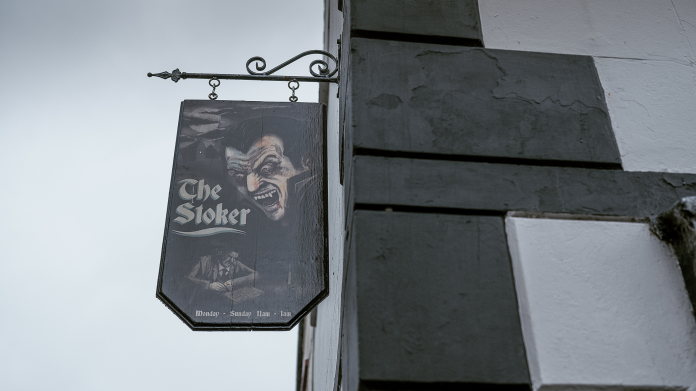When it comes to vampires, many people cite Transylvania as the clear influence. In fact, the origins of the infamous creatures seemingly begin in Ireland. Chris Baugh’s Boys From County Hell exposes this origin story within the first ten minutes, diving into a detailed account of how the Irish setting was the inspiration for Bram Stoker’s Dracula. The local pub even dons the name ‘The Stoker’ and it’s where this survival story begins. When a group of road workers awaken an ancient vampire, they must live through the night. The creatures name? The Abhartach.
The Abhartach has Celtic ties and legends state that the area of Glenullin was ruled over by a brutal chief. Because of his unsavoury behaviour, he was overthrown and buried by another chieftain, but the nightmare didn’t end. He returned and sustained himself by drinking the blood of his subjects. Sound familiar? Well, the only way to suppress him was to use a sword made of wood and submerge his body under a stone. Similar to the film, he is presumably buried in the middle of a field with ancient stones. The gravesite in County Hell appears intact and upcoming construction endangers it. In real folklore after locals began building projects, the stones were likewise affected.
The Alternate Source For Dracula
Bram Stoker was Irish and most likely grew up hearing the folktales of the Abhartach. It’s probable that his inspiration for Dracula began at home and during his studies there.
As Dr. Bob Curran points out in Vampires: A Field Guide to the Creatures That Stalk the Night, the setting of Dracula resembles Ireland more than it does Eastern Europe. “The roadside shrines, the dark woods, the small villages filled with superstitious peasants, all reflect the Ireland of the mid-1800s”, he argues. There appears to be a loose reference to this atmosphere in County Hell. When the group so desperately try to chase down the threat, it resembles a mob of villagers running with rakes to slay a vampire.
Eugene (Jack Rowan) goes as far as to call out the wrongful claim about the origins of the legend. Rowan does a brilliant job at this ,as you see that disdain and what the heritage means to the character as the film progresses. Interestingly, Eugene has a personal stake in the myth. His mother’s maiden name is similar to the chieftain that slayed the Abhartach, Cathán (or Ó Catháin).
In Dracula: The Shade and the Shadow, Professor Elizabeth Miller also challenges the popular belief, that Dracula was based on Vlad the Impaler, as Stoker didn’t know enough about the ruler in order to base his character around him.
Pop Culture’s Bloody Obsession
There’s no denying the oversaturation in the vampire genre. Yet the interest from the public shows that the appeal of these undying creatures is… well, undying. Studios continue to make projects featuring the undead as recently as last year, with BBC’s Dracula reboot starring Claes Bang. There is a certain allure that accompanies the genre that captures audience’s attention, and a fascination with immortality has almost become a part of human nature. But how can these many adaptations exist in unison?
Humour and horror is a peculiar duo that works. While legends are quite dark, pop culture has brought in a comedy element to many adaptations. Vampires on screen are often portrayed as charming and melodramatic; it fares well that they deliver the comedic relief through sarcastic one-liners. The prime example is the infamous Barnabas Collins, of the 1966 soap opera Dark Shadows, set in an imaginary town in Maine prone to supernatural incidents. The series gained a cult following after introducing the vampire and, similarly, the 2012 Tim Burton film of the same name adopts the Collins family story through a comedic lens.
Boys From County Hell reverts to the ‘fighting the monster’ mentality, but it effectively uses its human characters to lighten the mood. Buffy the Vampire Slayer adopts this tactic through its witty dialogue against the backdrop of a small town. County Hell tells the story through more grit and dry humour, mundane towns are a breeding ground for chaos and the latest film proves this appeal for audiences. Throw a group together to face a monster where humorous remarks are made in a panic, and something entertaining is bound to happen.
The Secrets To Vampire Slaying
Boys From County Hell is quick to debunk vampire stereotypes, pointing out that Dracula by Bram Stoker is indeed fiction and they won’t survive using the book’s advice. The usual methods of attack simply won’t fly. Instead, the lesser-known practice of burying the creature under rocks is plucked straight from the Irish legends. Other projects adopt their own characteristics that distinguish them in the genre. In The Vampire Diaries, for instance, the vampires wear daylight rings enchanted by witches to survive the sunlight. Netflix’s V Wars took a scientific approach, basing the vampires on a dormant virus causing their existence.
Given the broad spectrum of the paranormal creatures dominating every decade, their relevance is far from over. There even appears to be a True Blood reboot in the works. By reviving the forgotten Irish tale however, Baugh’s take stands out from the rest and will intrigue audiences with its authentic portrayal of folklore. Boys From County Hell is a comedic spin on the legend, utilising horror elements to overcome the misconception of the vampire origins.
Boys From County Hell is out in cinemas now.
Words by Olivia Gacka
Support The Indiependent
We’re trying to raise £200 a month to help cover our operational costs. This includes our ‘Writer of the Month’ awards, where we recognise the amazing work produced by our contributor team. If you’ve enjoyed reading our site, we’d really appreciate it if you could donate to The Indiependent. Whether you can give £1 or £10, you’d be making a huge difference to our small team.

